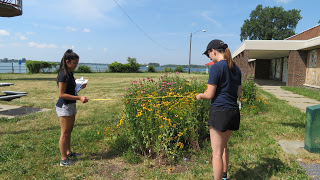January 8, 2019
By Gabbie Buendia (Rollins College) and Emily Rau (University of Wisconsin-Madison)
Our main focus this summer was working with the Rain Gardens to the Rescue program. This program teaches interested Detroit residents about the benefits and construction of rain gardens. Once residents graduate from the program, Friends of the Rouge and Sierra Club assist them in the creation of their own garden. After three years of training residents through these workshops, the goal is to create a secondary level program. This new program will train original program graduates to install rain gardens for other residents. To support the creation of this new program, we have been compiling evidence to help validate its need. In order to familiarize ourselves with this issue, we conducted market research on green stormwater infrastructure (GSI). The market research evaluated the potential of the GSI workforce in Detroit. The GSI workforce includes the installment and maintenance of rain gardens that program graduates would be involved in. We found that the job market can be accessible and profitable for many Detroit residents.
With this new understanding, we launched ourselves into the field to take inventory of the 52 rain gardens that had been planted around the city in the past three years. We took measurements, rated garden maintenance level, and took photos at each site in order to see how the gardens have been holding up. Finally, to fortify the value of residential rain gardens, we constructed and learned about water sensor nodes with the Real-Time Water Systems Lab at the University of Michigan. GI sensor nodes would be installed in rain gardens to measure the infiltration rate of stormwater through the soil. This data could then be used as evidence to showcase the efficiency of rain gardens.

Overall, this summer was filled with new experiences that have challenged us to learn new skills and have shown us the true beauty of Detroit. From the beginning of our research to our last measurement taken in the field, we have learned a number of lessons about green stormwater infrastructure, making change in the community, and conducting effective
collaboration. Below are just five of the lessons learned this summer that will have a lasting impact on us:
1. Rain gardens are most effective within a larger network of green stormwater infrastructure. Rain gardens may look small, but their impact can be big when paired with other green infrastructure all throughout the city. Rain gardens are cost effective and low maintenance, making them an ideal supplement for stormwater management. Additionally, rain gardens add beauty to the landscape, bringing native plants back to the area and removing pollutants from water. All of which leads us to our next lesson learned…
2. Fostering a sense of place and community improves the health of the environment. The Rain Gardens to the Rescue program gives Detroiters autonomy in beautifying their yards and pride in the landscapes that they have created. We met many residents that were proud of their beautiful rain gardens and excited about seeing more of them around the city. It is with this kind of enthusiasm that the strong networks of green stormwater infrastructure discussed above can thrive.
3. Water safety and security presents unique issues to cities all over the country. Although we have spent this summer learning about the Great Lakes water system, many of the issues and concerns are familiar. Among many factors, the future of Detroit’s water is threatened by pollution, invasive species, algal blooms, and poor infrastructure. These problems echo all throughout America. We aim to take the information and strategies on water safety that we learned in Detroit back to our hometowns.
4. Change requires collaboration. We went to many meetings this summer and witnessed many different working groups in action. Through it all, we have learned that these meetings and discussions are necessary for real, inclusive impact. Without collaboration, the distinct needs of the city, community organizations, and individual residents cannot be fully incorporated into meaningful plans for change.
5. Non-profit work requires versatility and flexibility. Our work this summer has taken us to places and introduced us to people that we would never thought we would be interacting with. This includes a visit to an engineering lab where we built a water sensor from scratch and a talk with a librarian about how to conduct market research. Although we did not have experience with many of the topics we encountered, being enthusiastic about learning made the process easier and more beneficial to everyone in the long run.
[Find the original post here: http://mi-environmental-news.blogspot.com/2018/07/2018-doris-duke-scholars-how-we-spent.html]